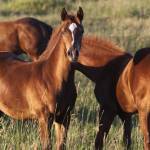Four Reasons All Horse Operations Need Biosecurity Protocols

In reference to horses, the term “biosecurity” simply refers to management strategies that minimize the introduction and spread of infectious diseases on farms. According to the American Association of Equine Practitioners, “Anything that touches an infected or suspect infected horse…may have the potential to transfer pathogens to other horses.”
Some equine infectious diseases can be fairly innocuous like a runny nose, mild cough, or self-resolving low fever. Others, however, are far more concerning such as equine herpes myeloencephalopathy (EHM, a mutant form of equine herpesvirus-1 that causes neurological signs), strangles, and diarrhea due to Salmonella or Clostridium difficile. Even horses with current vaccinations remain at risk for a number of other infectious diseases.
Here are four reasons to adopt and enforce biosecurity protocols to protect your horses, no matter how large or small the operation:
1. Protect the existing herd when introducing a new horse. Of course it is exciting to have a new horse arrive on the farm. Curb your enthusiasm, though, and heed expert warnings to keep that newbie isolated for 30 days before introducing him to the existing herd. This period gives you time to check the new arrival daily for signs of illness, including nasal discharge, cough, and fever. Be certain to use separate buckets, brushes, equipment, and thermometer for the new addition for the entire 30-day isolation period.
Horses that are taken off property for shows, other competitions, or breeding, for example, can be exposed to infectious diseases. Without biosecurity protocols, such horses can potentially spread infections to other horses on the farm after returning home. Any horse that leaves the farm should be isolated upon its return each and every time.
2. Protect the existing herd in the face of an infectious disease outbreak. If one or more horses do become ill, having strict biosecurity protocols in effect will minimize the chances of other horses on the farm becoming ill. Such protocols are similar to the introduction of a new horse, with separate equipment and buckets. Other measures include limiting the movement of insects and vermin between healthy and the sick horses in quarantine, and handling sick horses last or having a designated individual manage only sick horses.
“Newly introduced horses, horses that travel off property, and sick horses should also have their own feed supply to ensure no inadvertent cross-contamination occurs by the people feeding the horses,” advised Kathleen Crandell, Ph.D., an equine nutritionist at Kentucky Equine Research.
3. Loss of normal activity. Sick horses lose time from training, competition, breeding, or even just quality time spent with the owner while they are in isolation.
“Horses can lose condition due to the stress associated with the illness or they can gain weight due to being isolated in a small stall or pasture,” Crandell explained. “This can be particularly problematic for horses with special health considerations such as insulin resistance or equine metabolic syndrome in which routine exercise plays an integral role in keeping body condition in the 5-6 range and keeping feet healthy to avoid a bout of laminitis.”
4. Economics. Control of disease outbreaks is a costly endeavor. Veterinary examinations and medications, purchasing supplies for footbaths and protective clothing, and the added time for cleaning and disinfecting all add up quickly, even if the horse does not require hospitalization. Loss of income (from the inability of sick horses to perform their usual tasks) can also contribute to the overall costs associated with disease outbreak.
“Recall that human activity can also play an important role in the spread of equine infectious diseases. Veterinarians and farriers coming from other farms can inadvertently spread pathogens to other farms; delivery personnel and visitors that move from stall to stall touching and patting the horses can spread disease; and even personnel on the farm that breach biosecurity practices can all play a role in contamination,” concluded Crandell.








